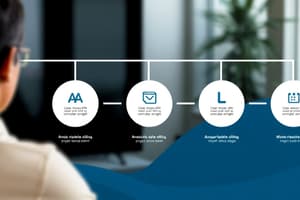Podcast
Questions and Answers
In Agile Project Management, what is the primary role of the Product Owner?
In Agile Project Management, what is the primary role of the Product Owner?
- Writing the code and designing the technical architecture of the software.
- Defining and prioritizing the features, functionalities, and overall vision of the product. (correct)
- Ensuring that the project adheres to the original scope and timeline defined at the outset.
- Managing the development team's daily tasks and removing obstacles to their progress.
Which of the following best describes the function of a 'User Story' in Agile project management?
Which of the following best describes the function of a 'User Story' in Agile project management?
- A detailed technical specification document for developers.
- A comprehensive legal agreement outlining the project's scope and limitations.
- A complex mathematical model used to predict project outcomes.
- A short description of a feature or functionality from the end user's perspective. (correct)
What is the purpose of a 'Product Backlog' in Agile methodology?
What is the purpose of a 'Product Backlog' in Agile methodology?
- To serve as a comprehensive archive of all completed project documentation.
- To provide a prioritized list of tasks, features, and user stories yet to be implemented. (correct)
- To maintain a detailed log of all bugs and defects identified during testing.
- To outline the project's marketing and sales strategy.
What is the primary role of the Scrum Master in an Agile project?
What is the primary role of the Scrum Master in an Agile project?
What is the significance of a 'Sprint' in Agile project management?
What is the significance of a 'Sprint' in Agile project management?
How does 'Release' function within the Agile framework?
How does 'Release' function within the Agile framework?
What is the primary focus of the 'Initiation' phase in Agile project management?
What is the primary focus of the 'Initiation' phase in Agile project management?
How does Agile Project Management differ from Waterfall Project Management regarding planning and execution?
How does Agile Project Management differ from Waterfall Project Management regarding planning and execution?
What is the purpose of delivering completed work to the Product Owner (and end-users) at the end of each Sprint?
What is the purpose of delivering completed work to the Product Owner (and end-users) at the end of each Sprint?
During the 'Planning' phase of a Sprint, what is the purpose of refining the Product Backlog?
During the 'Planning' phase of a Sprint, what is the purpose of refining the Product Backlog?
In the 'Design' phase of a Sprint, what is the purpose of creating wireframes?
In the 'Design' phase of a Sprint, what is the purpose of creating wireframes?
During the 'Test' phase of each Sprint, what are the two key perspectives considered when testing?
During the 'Test' phase of each Sprint, what are the two key perspectives considered when testing?
What is the main task during the 'Deploy' phase of each Sprint?
What is the main task during the 'Deploy' phase of each Sprint?
Why is a 'Retrospective Meeting' conducted by the Scrum Team?
Why is a 'Retrospective Meeting' conducted by the Scrum Team?
What is the primary objective of 'Project Closure' in Agile Project Management?
What is the primary objective of 'Project Closure' in Agile Project Management?
For projects with very clear customer requirements from the beginning and a stable project environment, which project management approach is typically more suitable?
For projects with very clear customer requirements from the beginning and a stable project environment, which project management approach is typically more suitable?
In digitalization projects, how do end-user needs typically evolve, making Agile a potentially more suitable approach?
In digitalization projects, how do end-user needs typically evolve, making Agile a potentially more suitable approach?
What is a 'Definition of Done' in Agile project management, and why is it important?
What is a 'Definition of Done' in Agile project management, and why is it important?
During the Sprint Review, what is the team expected to do with the completed work?
During the Sprint Review, what is the team expected to do with the completed work?
What action is typically performed to kick off the 'Sprint Backlog'?
What action is typically performed to kick off the 'Sprint Backlog'?
Flashcards
Waterfall Project Management
Waterfall Project Management
A project management approach best suited when customer requirements are clear from the start and the project environment is stable.
Agile Project Management
Agile Project Management
A project management approach that embraces iterative development and flexibility to changing requirements.
Product Owner
Product Owner
Individual responsible for defining product features, prioritizing them, and maintaining the overall project vision.
User Story
User Story
Signup and view all the flashcards
Product Backlog
Product Backlog
Signup and view all the flashcards
Scrum Master
Scrum Master
Signup and view all the flashcards
Sprint
Sprint
Signup and view all the flashcards
Release
Release
Signup and view all the flashcards
Initiation (Inception)
Initiation (Inception)
Signup and view all the flashcards
Sprint Iteration
Sprint Iteration
Signup and view all the flashcards
Planning Phase of Sprint
Planning Phase of Sprint
Signup and view all the flashcards
Design Phase of Sprint
Design Phase of Sprint
Signup and view all the flashcards
Development Phase of Sprint
Development Phase of Sprint
Signup and view all the flashcards
Test Phase of Sprint
Test Phase of Sprint
Signup and view all the flashcards
Deploy Phase of Sprint
Deploy Phase of Sprint
Signup and view all the flashcards
Review Phase of Sprint
Review Phase of Sprint
Signup and view all the flashcards
Release Phase of Sprint
Release Phase of Sprint
Signup and view all the flashcards
Project Closure
Project Closure
Signup and view all the flashcards
Study Notes
- Projects following a "top-down"/"from-beginning-to-end" sequence are considered a Digitalization Project.
- The "Waterfall Project Management" or "Classic Project Management" is best for projects with clear customer requirements from the beginning, and that the project environment is unlikely to change significantly.
- Waterfall Project Management presents challenges for projects where end user requirements remain unclear at the start, which is common in complex digitalization projects.
- In digitalization projects, end users' specific needs evolve through interaction and experimentation with a basic version of the new system.
- Agile Project Management addresses the issue of bypassing user needs.
Agile Project Management
- ‘The Agile Manifesto' was published in 2001 by 17 software developers.
- Instead of combining all planning into one phase, then all execution into a follow-up phase, Agile Project Management alternates "planning" and "executing" in iterations allowing users to request changes throughout the project.
Key Agile Project Terms
- Product Owner is responsible for defining, prioritizing features, functionalities, and the overall vision of the product
- User Story is a short description of features and functionalities an end user wants from a product
- Product Backlog is a prioritized list of tasks, features, or user stories that need to be completed, serving as a project "To Do" list, populated throughout the project's lifecycle to incorporate new user requests
- Scrum Master is responsible for planning and moving the project forward (Project Manager), and leads the Scrum Team
- Sprint is each iteration of an Agile Project, the Scrum Team identifies tasks based on the Backlog and completes them here
- A Sprint is typically planned for a Timebox of one to four weeks
- Release refers to a specific version of a product that is made available to users
- A Release is often a result of a specific Sprint, then demoed by end users, whose feedback updates the Product Backlog
Initiation Phase
- Also known as "Needs Identification & Requirements Analysis" or “Inception”.
- Elements include:
- Identifying Product Owner Requirements, "bird's eye perspective” requirements for the entire project and detailed requirements for the first sprint
- Designing a Product Roadmap, documenting the project's major milestones, releases, and deliverables
- Creating a first Product Backlog with a list of features for the project must deliver, e.g. in the form of User Stories
- Release planning, providing an overview of with features will be dealt with per sprint or “Timebox"
- Agreeing on a Definition of Done, which creates mutual understanding of what it means for the project to be complete
- Discovery and Research, which analyzes analyzing current systems and processes, gathering requirements
Sprint Iteration
- Small cycles of “System Design”, “System Development”, “Integration”, “Implementation”, and "Training/Change Management" until the Definition of Done has been reached
- In Agile, Project Management is based on repeated cycles of planning and executing
- Sprints are scheduled for one to four weeks with work selected from the Product Backlog, then planned and executed
- The work is delivered to the Product Owner and end users, who make requests
(1) PLAN
- The tasks include:
- Refining the Product Backlog to ensure the user story is well defined and contains sufficient detail
- Estimating the size and complexity of each User Story by assigning points to each story
- Selecting suitable User Stories for inclusion in the Sprint, which are moved to a Sprint Backlog, which depends on the team's historic work speed
(2) DESIGN
- Tasks include:
- Identifying solutions for the user stories features prioritized for the sprint
- Creating a plan for how these solutions will be created based on wireframing, prototyping, and mock-ups
(3) DEVELOP
- The main task is:
- Creating the features functionalities from the User Stories of the Sprint, created in the Design Phase, and involve programming, purchasing hardware and/or software, installing hardware and/or software
(4) TEST
- The task is:
- Testing the features and functionalities which were previously created in the Sprint from a technical and user perspective (i.e. ensuring the output functions per the end user's expectations)
(5) DEPLOY
- The task is:
- Setting up the output of the Sprint in the live environment and includes migration processes
(6) REVIEW
- During the Sprint Review, involve live demonstrations or presentations for feedback, questions, suggestions, and requests, which are added to the Product Backlog
(7) RELEASE
- This involves:
- Making the completed work of the Sprint available to end users
- End users can make request based on this phase
CLOSURE
- Occurs during the final phase of Agile Project Management, Project Closure.
- Formally present the completed work to the Product Owner
- Hand over the completed work to the support or maintenance team
- Conduct a Retrospective for analysis of what went well and documenting the project
- Evaluating and successfully and symbolically end the project
Studying That Suits You
Use AI to generate personalized quizzes and flashcards to suit your learning preferences.




